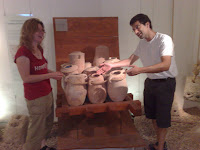 Kati Mäkitalo-Siegl, Jan Zottmann, Frederic Kaplan and Frank Fischer organized a workshop that resulted in the book: Classroom of the Future. The book gives a very good overview and is in my view very well suited to run a seminar
Kati Mäkitalo-Siegl, Jan Zottmann, Frederic Kaplan and Frank Fischer organized a workshop that resulted in the book: Classroom of the Future. The book gives a very good overview and is in my view very well suited to run a seminar
We have one chapter in the book that talks about teaching beyond the classroom and outside a typical classroom using pervasive computing technologies [1]. Our chapter includes some of the work on tangible interaction we did in Munich, e.g. [2] and earlier experience where we did a school garden blog (in German only http://www.hcilab.org/albrecht/flachs-web/).
Details about the book and a free preview are available at the publisher’s side. The free preview includes an article on the classroom of the past – which I found quite interesting. If you are interested in our article, drop me a mail and I may find the draft.
[1] Paul Holleis, Albrecht Schmidt, Heiko Drewes, Richard Atterer, Petra Dollinger. Teaching Beyond the Classroom: Pervasive Computing Technologies for the Classroom of the Future. Classroom of the future. SensePublisher 2010, pp 63-85. ISBN:978-9460911026 (book at amazon)
[2] Terrenghi, L., Kranz, M., Holleis, P., and Schmidt, A. 2006. A cube to learn: a tangible user interface for the design of a learning appliance. Personal Ubiquitous Comput. 10, 2-3 (Jan. 2006), 153-158. DOI= http://dx.doi.org/10.1007/s00779-005-0025-8


